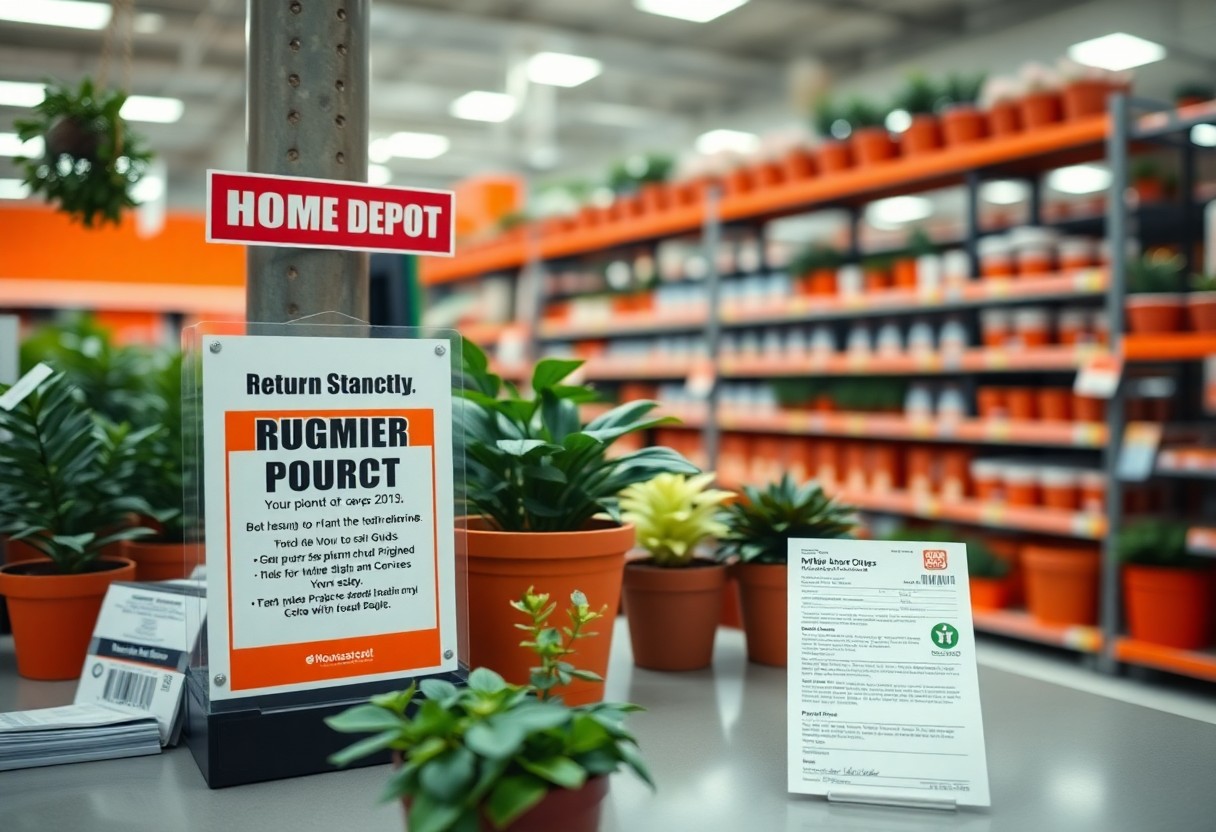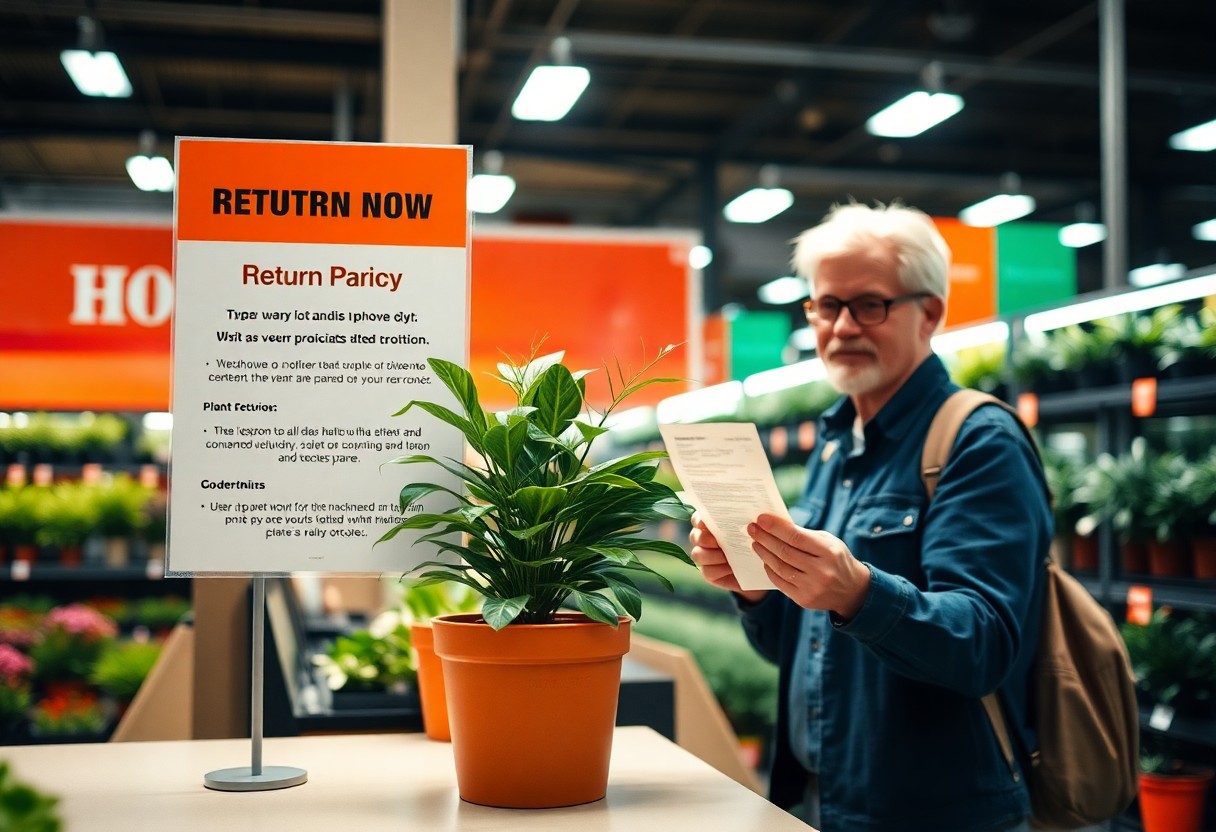You may find yourself needing to understand Home Depot’s return policy on plants to ensure a smooth shopping experience. Home Depot allows you to return plants within 90 days of purchase, provided they are accompanied by a receipt. If your plant is unhealthy or not thriving, you can rely on their satisfaction guarantee for a possible refund or exchange. However, perishable items like live plants may have specific conditions, so familiarize yourself with the rules to avoid surprises when returning. Your knowledge of these policies will help make the most of your gardening investments.
Strategies for Successful Plant Purchases at Home Depot
Selecting the Right Plants for Your Environment
Consider your local climate, available sunlight, and soil conditions when selecting plants at Home Depot. Not all plants thrive in every environment; for example, succulents prefer well-drained conditions typical of arid climates, while ferns flourish in moist, shaded areas. Researching the hardiness zone specific to your region can guide you toward plants that are more likely to thrive in your garden. Use signage within the store, which often provides helpful information about light and water requirements for each plant species.
In addition to climate, think about your gardening goals and aesthetic preferences. If you’re looking to attract pollinators, focus on flowering plants that are known for their nectar, such as coneflowers and bee balm. For a low-maintenance garden, consider native plants that are adapted to your area and can survive with minimal upkeep. Some of these plants also offer resilience against pests and diseases. Combining flowers with varying bloom times can provide seasonal interest and support your local ecosystem.
Assessing Plant Health Before Purchase
Inspecting plants before purchase is crucial to ensure that you’re investing in healthy specimens. Look for signs of vitality, such as vibrant green leaves without discoloration or spots, which often indicate stress or disease. Stems should be firm, not wilted or mushy, and the overall structure of the plant should appear robust. A thorough examination can help you avoid the disappointment of bringing home a plant that may struggle to survive.
Pay attention to the root system as well. Healthy roots are usually many, dense, and light-colored. A plant with roots that are brown or significantly pot-bound may struggle to adjust once planted in your garden. Home Depot’s knowledgeable staff can assist with plant selection, providing further advice on the health and suitability of specific plants for your needs.
Assessing plant health before purchase takes a keen eye; carefully scrutinize each specimen for pests or potential diseases. Look under leaves and near the base of plants for any hidden signs of infestation or mildew. Avoid plants with open wounds or scars, as these can lead to infections. By taking a moment to inspect, you can ensure that the plants you choose bring vibrant life to your home rather than becoming a source of frustration later on.

Decoding Home Depot’s Return Policy on Plants
Key Conditions for Plant Returns
The return policy for plants at Home Depot is generally favorable, but there are specific conditions you must meet. For live plants, Home Depot accepts returns only within a designated period, so you should act promptly if you notice any issues. Plants must be in a condition that clearly indicates their state, whether healthy or unhealthy, and you will need to present a valid receipt as proof of purchase.
Plants that show signs of damage from external factors, such as improper care following purchase, or those that have been significantly altered may not be eligible for a return. Additionally, Home Depot does not accept returns on plants that have been planted in your garden or landscape, so keep this in mind when planning your garden project.
Time Frames and Documentation Required
Typically, you have up to 90 days from the purchase date to return your plants for a full refund, provided you meet all other conditions. Documentation you will need includes your receipt, which should clearly indicate the transaction date and details of the plants purchased. Without this proof, getting a refund or exchange may be challenging.
Some special orders or seasonal plants may have different time frames and conditions, so always check with an associate when making your purchase for the most accurate and up-to-date information. If you find a plant that isn’t thriving, act quickly within the given timeframe to ensure your return process goes smoothly. Always keep your purchase records organized to facilitate this process.
Common Challenges Faced When Returning Plants
Identifying Issues with Plants After Purchase
Recognizing problems with your plants can be tricky, especially if you’re not familiar with the signs of distress. Common indicators include yellowing leaves, stunted growth, or pests, which may not become apparent until days or weeks after purchasing. If you notice these issues shortly after bringing your plants home, it becomes important to determine whether they stem from factors like improper care or pre-existing conditions from the store. Documenting the symptoms through photos or notes can provide valuable evidence if you decide to pursue a return.
Be aware that plants often require specific environmental conditions to thrive, which may not align with those at the store. This lack of environment adaptation can lead to further challenges. Utilizing knowledge from associates in-store or researching common plant care tips could help you assess potential issues early on and aid in making informed decisions when returning plants that don’t meet your expectations.
Navigating Customer Service Experiences
Customer service interactions can vary widely when attempting to return plants. Instances of communication breakdowns may occur, especially during peak seasons when staff are busy and may have less time to assist you effectively. Providing clear details about your issue, along with any documentation you’ve gathered, can expedite the process significantly. If you’re facing resistance, it’s beneficial to remain calm while firmly outlining the plant’s condition and your reasons for seeking a return.
Patience and persistence are vital. You may need to engage with multiple representatives before getting the desired resolution. Consider contacting Home Depot’s support via phone or chat, which can sometimes yield faster results than in-store visits. Taking note of the representative’s name and any reference numbers can help keep your case organized and ensure you receive consistent service throughout your experience.
Alternative Solutions to Plant Returns
Tips for Reselling or Gifting Unwanted Plants
If you find yourself with unwanted plants after your shopping trip, consider reselling them online through platforms like Facebook Marketplace or Craigslist. Highlight the health and beauty of the plants in your listings, including care tips to attract potential buyers. Alternatively, hosting a garage sale or a plant swap event in your community can also be effective. Gifting plants to friends or family, especially those with a passion for gardening, not only clears space in your home but can also foster connections and shared interests.
- Take clear, appealing photos that showcase the plant’s condition.
- Be honest about the plant’s needs and care requirements.
- Consider seasonal timing to maximize interests, like spring for gardening enthusiasts.
Any method of reselling or gifting increases the chances that your unwanted plants will thrive in a new environment, preventing waste and benefiting others in your circle.
Creative Options for Plant Regrowth and Care
Instead of discarding plants that may seem lifeless, exploring their potential for revival could lead to rewarding outcomes. For instance, researching specific care techniques or repotting methods can vastly improve a plant’s health. Techniques like pruning dead leaves, adjusting watering schedules, or assessing sunlight exposure can play a significant role in revitalizing your greenery. You could also join online forums or local gardening clubs to learn from experienced plant enthusiasts who have successfully nurtured struggling plants back to life.
Dedicating time to plant care may yield gratifying results, enhancing both your knowledge and your home environment. Look into specific treatments such as providing organic fertilizers or making adjustments to humidity levels, which are often overlooked yet crucial elements in supporting plant health. Engaging with resources like gardening books or visiting local nurseries can provide additional insights into maximizing your plants’ potential.

Real Customer Experiences with Plant Returns
Positive Outcomes and Success Stories
Many customers have shared uplifting experiences after returning plants to Home Depot. One homeowner recounts successfully returning a sickly fern that had wilted within days of purchase. With the assistance of the friendly customer service team, they exchanged it for a vibrant, healthy specimen, highlighting the company’s commitment to customer satisfaction. Others have noted how easy the return process was, often describing it as straightforward, with little to no hassle involved.
Particularly commendable is the responsiveness of a few local Home Depot stores, which have implemented clear signage and dedicated staff to assist with plant returns. This not only streamlined the process but also educated customers on how to care for their new purchases, reducing future return rates. Your positive experiences can serve as a reminder of Home Depot’s focus on quality and reliable service.
Frustrations and Lessons Learned
Despite the overall positive feedback, some customers encountered frustrating hurdles during the return process. Issues often arose from vague return policies or discrepancies in knowledge among store staff regarding specific plants. For instance, a customer mentioned facing difficulty when trying to return a plant that was deemed “non-refundable” due to its clearance status, leaving them feeling confused and unsupported. Additionally, there are reports of long wait times during peak hours, leading to added frustration when attempting to resolve plant-related concerns.
Lessons learned from these experiences often emphasize the importance of thoroughly reading plant care instructions and return policies prior to purchasing. Understanding the specific requirements for different plants can reduce the likelihood of returns and enhance the overall satisfaction with your selections. Equipping yourself with knowledge empowers you to make informed choices, thus minimizing potential disappointments in the future.
To wrap up
Summing up, when you purchase plants from Home Depot, it’s important to understand their return policy to ensure your satisfaction. You can return your plants within 30 days of purchase with a receipt, allowing you to exchange or refund if the plants do not meet your expectations. Make sure to keep your receipt and check the condition of the plants before finalizing your purchase, as this can affect your ability to return them.
Additionally, Home Depot’s customer service will assist you in navigating the return process if needed. You can feel confident in your purchases knowing that there is a structured policy in place to support you should you encounter any issues with your plants. This flexibility enables you to enjoy your gardening endeavors without the stress of potential dissatisfaction.
FAQ
Q: What is Home Depot’s return policy for plants?
A: Home Depot allows returns of live plants within 90 days of purchase. Plants must be in their original condition and packaging, along with the receipt for a full refund or exchange.
Q: Are there any exceptions to the return policy for plants at Home Depot?
A: Yes, exceptions include seasonal plants and those marked as non-returnable at the time of purchase. It’s necessary to check individual plant labels for specific return guidelines.
Q: How do I return a plant that I purchased from Home Depot?
A: To return a plant, bring it to the Customer Service Desk at any Home Depot location. Present your receipt or proof of purchase, and ensure the plant is in good condition for a smooth return process.